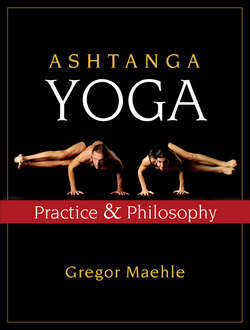Читать книгу Ashtanga Yoga - Gregor Maehle - Страница 119
На сайте Литреса книга снята с продажи.
Vinyasa Two
ОглавлениеExhaling, shorten the stance slightly and turn the back foot in 45°, as we do in all standing postures where the hips are squared. The right foot is turned out 90°. Keeping the back leg straight, again track the right knee over the right ankle. Squaring the hips, hook the left shoulder outside the right knee (the emptier the lungs are the easier this is). You can assist yourself by pressing the right thigh toward the center with your right hand. Press the left hand into the floor outside the foot, spreading the fingers.
Now take the right arm overhead to form a diagonal line from the left foot to the right hand. The palm faces downward, the face is turned toward the right arm, and the gaze is up toward the palm. Spread the base of the toes of the back foot to encourage the leg to be straight and strong. Strong abduction of the right knee, countered by the left arm, will inspire the spine to spiral.
Do not fake the spinal twist by letting your right hip sag toward the floor, but work the hips toward being level and square. Lift the shoulder blade off the neck and draw it down away from the ear.
Keep the lower abdomen firm and use deep breathing into the chest to elongate the spine. Create space between the left shoulder and right hip. Extend out simultaneously through your sit bones and through the crown of the head. Hold Parivrta Parshvakonasana for five breaths.
YOGIC CONTEXT
Intelligent Action
Any movement in a posture can be over-exercised, and at any stage one should be able to initiate its countermovement, which is to retract the action. This is intelligent action.
Most muscles have more than one action. For example, latissimus dorsi primarily extends the humerus.8 It also medially rotates the humerus. The first of the two actions indirectly causes the arm to bend at the elbow. This is counteracted by the deltoid, which flexes the humerus (raises the arm above the head). The medial rotation of the humerus calls the infraspinatus into play. One action is played against its opposite to reach the desired balanced posture.
For beginners who cannot enter the posture in one breath, it may be approached in phases:
• Turn to face the right leg and place the left knee on the floor. Keeping the leg bent, hook the left shoulder outside the right knee and press the left hand into the floor.
• Keeping the knee over the ankle and the shoulder hooked outside the knee, lift the back knee off the floor and straighten the leg.
• Maintaining all of the above, work the left heel down, placing the foot at a 45° angle.
• Raise the right arm and gaze at the palm.
Stay at any of these phases for as long as necessary until the stage is attained. In this way your integrity in the posture is not sacrificed. Once you can do the complete posture, attempt to enter into it on one breath.
